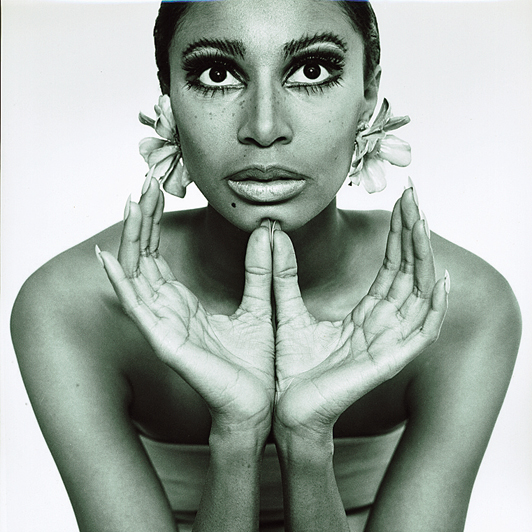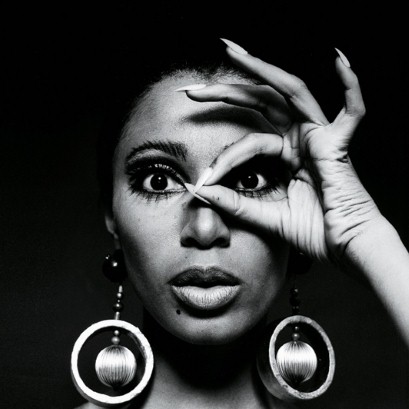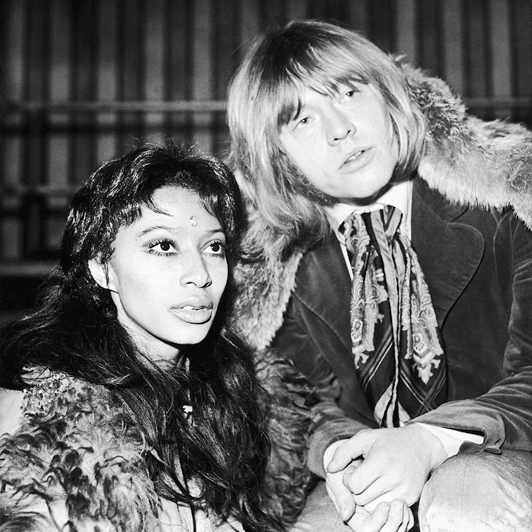11 NOVEMBER 2012
The tragic tale of
Donyale Luna
The world’s first black cover girl,
Donyale Luna overcame deep
prejudice to land a stellar modelling
career. Then it all ended just as
suddenly as it had started. Ben
Arogundade takes up her tragic story.
BY BEN AROGUNDADE
‘Look at this extraordinary apparition.’ It was New York, 1964, and Nancy White, theHarper’s Bazaar editor, and her fashion team were gazing at the face and figure of a new teenage model, fresh in from Detroit. Donyale Luna was 5ft 11in, a shade over 8st, flat-chested and X-ray skinny. Her legs were as stilt-like as a Giacometti sculpture, her fingers extended and spidery. She had caramel-coloured skin, almond-shaped eyes, full lips and an oval-shaped face, which, in certain poses, retained an owlish surprise, as if she’d just been pinched from behind. Her racial mix was the perfect precursor to the multiracialism of America’s Obama generation. Her mother was of African-American and European heritage, while her father was of African-American and South American Indian (Quechuan) ancestry. She didn’t fit the aesthetic stereotype for what many thought of as black beauty. Her look was otherworldly, plain and simple.
Largely forgotten today, Donyale Luna was one of the first women to carve the aesthetic space into which today’s non-white models exist. There has never been a better time in history to be a black model. Naomi Campbell is worth a reported £30 million, and the Puerto Rican-born Joan Smalls – a face of Estée Lauder – is the number-one model in the world this year, according to models.com. Yet until the advent of the American Civil Rights Movement in the 1950s and 1960s the fashion industry operated its own kind of apartheid, which entirely excluded non-white models from its magazines, advertising and catwalk shows.
Donyale Luna was the first black model who really began to change things; to enable more diverse beauty paradigms to break through. Aptly, perhaps, she was discovered on a Detroit street in the same year as the Civil Rights Act, which prohibited discrimination based on race, colour, religion or national origin.
‘I was stunned,’ recalled the photographer David McCabe of his 1964 sighting of the Catholic schoolgirl in her kilt school uniform. ‘She was so tall and so slender, and had the most incredible bone structure.’ He invited the 18-year-old to New York, where she was introduced to Nancy White. White was so impressed by the young beauty that she immediately had her sketched by an illustrator, and the result ran on the cover of the January 1965 edition of Harper’s Bazaar , the first ever to feature a black model.
In a letter to her childhood friend Mary Ann, Luna wrote, ‘New York is a dream… a man danced me down Fifth Avenue, and all up and down Broadway men were eyeing and whistling at me, and so many other unbelievable things. I’m really getting the works from head to toe by Harper’s Bazaar’s best! As soon as possible I’ll send you a picture of the new me. I’ll be on top of the world if it takes every breath I have, every muscle of my skinny body. I feel it, I know it. I’ll be some kind of star real soon. Real soon.’
Luna was put on a one-year contract with Bazaar’s staff photographer, Richard Avedon. His first pictures of the model debuted in a groundbreaking six-page feature in the April 1965 edition of the magazine. An accompanying caption to the clothes read, ‘As worn by Donyale Luna with all the grace and strength of a Masai warrior.’ The Herald Tribune ran an article condemning the caption as an example of racial prejudice and exploring the problems of the African-American working girl. Nevertheless, after years of discrimination, black beauty had suddenly arrived in mainstream fashion. ‘Avedon’s photos of Luna’s sinewy, spidery limbs, cobra-shaped face and hermetic poise evoked thunderclaps of attention,’ wrote Joel Lobenthal inRadical Rags: Fashions of the Sixties .
Remarkably for a rookie, Luna had skipped modelling’s apprenticeship stage of endless castings and rejections, and come straight in at the top. Yet only three months after her historic cover she faced sudden tragedy. She received word that her father had been shot dead by her mother in self-defence, after he had come home drunk and threatened her. Luna by now had a host of famous friends to comfort her, including Sammy Davis Jr, Miles Davis and Andy Warhol. But she also increasingly found a dangerous kind of solace in alcohol and drugs, both ubiquitous in her newly adopted world.
‘That was the time she started to do things she shouldn’t have,’ remembered McCabe. ‘It was all very free-spirited. Everyone was doing stuff, LSD and more harmful things.’ Luna was hanging out with some of New York’s most creative people. But paradoxically they were also among the most destructive in the influence that their drug-taking would ultimately have on the naive young model who, when she first arrived in the city, neither drank nor smoked, and would lecture her fellow models on how ‘disgraceful it was to smoke pot’.
Her fledgling career began to stutter. Avedon put it down to ‘racial prejudice and the economics of the fashion business’ . His photographs of Luna in Bazaar had prompted advertisers in the southern states to pull their advertising, while readers had cancelled subscriptions. William Randolph Hearst, the owner of Bazaar, did not approve, and told Nancy White as much. ‘I was never permitted to photograph her [Luna] for publication again,’ Avedon later lamented.
In 1965 Luna defected to London, where she became an instant hit. Soon she was being photographed by David Bailey, William Klein, Helmut Newton and William Claxton. It was Claxton who introduced her to Salvador Dalí, who in turn declared her ‘the reincarnation of Nefertiti’. She made history again on March 1966, when she became the first black model to feature on the cover of British Vogue in a stylish, Picasso-influenced composition shot by David Bailey, in which one of Luna’s eyes peered suggestively from between her fingers. That same year the photographer Charlotte March created her own version of Luna’s signature pose for a German fashion magazine, Twen . Donyale Luna With Earrings – a fierce black-and-white close-up of her face – was to become one of the most iconic fashion images of the Swinging Sixties.

Luna in one of the images from Charlotte March’s shoot for Twen magazine, 1966 courtesy of Charlotte March/Collection Falckenberg
But nowhere was Luna more creative than in the assemblage of her own alter ego. She turned herself into a shape-shifting enigma, inventing a series of fantasies and untruths. She loved toying with friends, lovers and journalists alike, making up stories about herself that were designed to amuse or shock. When asked where she came from, Luna would reply, ‘I’m from the moon, darling.’ She told one boyfriend that her parents were killed in a car accident and that she was adopted. She once informed the Italian press that she ate three kilos of meat a day.
Luna’s success in London brought her a new corral of celebrity friends – Mick Jagger, Michael Caine, Julie Christie, Mia Farrow and Yul Brynner among them. She dated the actor Terence Stamp, and Brian Jones of the Rolling Stones. Everyone who met her seemed to have an engaging anecdote.
‘She had no tits, but lots of presence,’ quipped her model friend Pat Cleveland. ‘We’d walk down the street and men’s mouths would drop open in awe. When we walked into restaurants people would stop eating and stand up and applaud. She was like a mirage, or some kind of fantasy.’ At a New York nightclub in 1966 Jackie Kennedy went up to Luna and simply said, ‘You are very beautiful.’
During her time in London Luna avoided any involvement with the civil-rights movement that was raging back in America. Undeniably her career, beautifully timed, was built on the gains – and the blood – of the movement, but she remained determinedly disengaged.
‘The civil-rights movement has my greatest support, but I don’t want to get involved racially,’ she once said. In a 1968 interview, when asked if she hoped that her success might open more doors for African-American women, she replied, ‘If it brings about more jobs for Mexicans, Chinese, Indians, Negroes – groovy. It could be good, it could be bad. I couldn’t care less.’ Comments like these did nothing to endear her to America’s ethnic minorities, but it did much to enhance her reputation as a racial outlaw who refused to be typecast as one of the era’s civil-rights gladiators.
And all the while, alongside her achievements and controversies, lay the spectre of drugs. In a New York Times profile she once confessed to taking LSD. ‘I think it’s great,’ she said defiantly. Soon after she moved in with the actor Klaus Kinski in 1969 he threw her out for excessive drug-taking. Inevitably, her work was affected. ‘She didn’t show up for bookings,’ remembered her fellow black model Beverly Johnson. ‘She didn’t have a hard time, she made it hard for herself.’ And at the age of 32 the drug-taking finally caught up with Donyale Luna. Estranged from her then husband, an Italian photographer, she died in Rome in the early hours of 17 May 1979 of an accidental heroin overdose. She left behind an 18-month-old daughter, Dream.
Ben Arogundade’s new eBook on Donyale Luna is out now ( arogundade.com )
>via: http://fashion.telegraph.co.uk/news-features/TMG9658276/The-tragic-tale-of-Donyale-Luna.html


